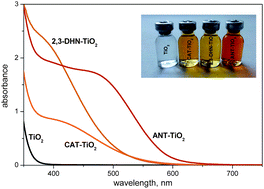Surface modification of anatase nanoparticles with fused ring catecholate type ligands: a combined DFT and experimental study of optical properties†
Abstract
Surface modification of nanocrystalline TiO2 particles (45 Å) with catecholate-type

* Corresponding authors
a
University of Belgrade, Vinča Institute of Nuclear Sciences, P.O. Box 522, Belgrade, Serbia
E-mail:
ivanaj@vinca.rs
Fax: +381-11-3408607
Tel: +381-11-8066428
b Department of Chemistry, University of Belgrade, Studentski trg 16, P.O. Box 158, Belgrade, Serbia
Surface modification of nanocrystalline TiO2 particles (45 Å) with catecholate-type

 Please wait while we load your content...
Something went wrong. Try again?
Please wait while we load your content...
Something went wrong. Try again?
T. D. Savić, I. A. Janković, Z. V. Šaponjić, M. I. Čomor, D. Ž. Veljković, S. D. Zarić and J. M. Nedeljković, Nanoscale, 2012, 4, 1612 DOI: 10.1039/C2NR11501H
To request permission to reproduce material from this article, please go to the Copyright Clearance Center request page.
If you are an author contributing to an RSC publication, you do not need to request permission provided correct acknowledgement is given.
If you are the author of this article, you do not need to request permission to reproduce figures and diagrams provided correct acknowledgement is given. If you want to reproduce the whole article in a third-party publication (excluding your thesis/dissertation for which permission is not required) please go to the Copyright Clearance Center request page.
Read more about how to correctly acknowledge RSC content.
 Fetching data from CrossRef.
Fetching data from CrossRef.
This may take some time to load.
Loading related content
